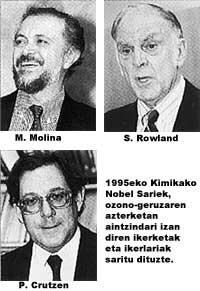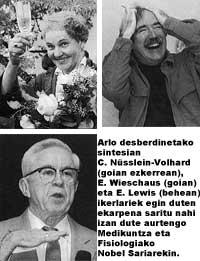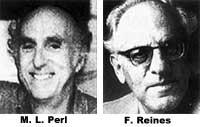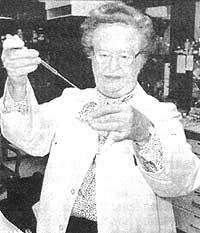Nobel Prize in Chemistry, Physics, Physiology and Medicine
1995/12/01 Agirregabiria, Juan M. | Aizpurua Sarasola, Joxerra | Txurruka, Jesus Mari - Genetika, Antropologia Fisikoa eta Animalien Fisiologia SailaEHU | Zubiaga, Ana Iturria: Elhuyar aldizkaria
Chemistry
- Mario Molina
- Sherwood Rowland
- In Paul Crutz
The first official news of the ozone hole was published in 1985 by an article published by a group of researchers in the journal Nature. Since then it is something we have heard many times. The debate that sparked this news made CFC substances famous and today there is an almost absolute international consensus on the responsibility of CFCs. In fact, with the thinning of the ozone layer, low-frequency ultraviolet rays harmful to living beings will reach the troposphere in greater amounts than today, increasing the risk of skin cancer and genetic changes.

However, ozone hole precursors are found in the 1970s. Already at this time several researchers demonstrated that chlorine of CFC substances eliminated stratospheric ozone. The prizes of this year can therefore be considered as a continuation of the path undertaken at this time. In fact, the 1995 Nobel Prize in Chemistry has awarded pioneering researchers and research in this field.
It is clear, on the other hand, that the Nobel Laureates began to receive ever more rigorous criticism, since the sciences related to the environment were never considered as such; however, this year's awards have taken an important step in the consideration of chemistry as an aspect that traditional chemistry did not consider its scope.
Award-winning researchers work in the US and Germany. On the one hand, Mario Molina, of the Massachusetts Institute of Technology, and Sherwood Rowland, of the University of California, in Irvine, and on the other, Paul Crutz, of the Max Plank Institute of Mainz, have been the winners of this year.
Crutzen demonstrated in 1970 that nitrogen oxides appeared as catalysts in the disappearance of ozone and in 1974 Molina and Rowland suspected that the chlorofluoro hydrohead, that is, the CFCs were directly related to the disappearance of ozone. Most of the work done since then is based, therefore, on the research of these pioneers.
Physics
- Martin L. Perl
- Frederick Reines
Martín L., who works in California. Perl and Frederick Reines have been the physicists who have received this year the Nobel Prize in Physics for their “advanced experimental contributions to the physics of leptois”. The Royal Swedish Academy of Sciences has awarded Perl and Reines for “neutrino detection” for “tau leptoia discovery”.
The physics of leptois (and the physics of elementary particles) was born in the last years of the last century, J.J. When Thomson found the electron. XX. By the beginning of the 20th century, cathodic rays and b rays are electrons, but the mechanism that produces them, known as b disintegration, was not understood.
In 1930 the scientist Wolfang Pauli postulated that in process b, in addition to the electron, another particle is emitted and baptized as neutrino. The proposal was very brave, since Pauli himself thought that the interaction of the neutrino with the environment was too weak and that it would never be detected. Pauli's certainty was based on solid theoretical principles. In order to preserve the principles of permanence so prolific in physics, the participation of some other particle in this process was essential. The future has shown us that Pauli is one of the most forceful predictions of theory. Enrico Fermi used the neutrino hypothesis by launching the theory of weak interaction; physicists accepted it unanimously, but as usual, experimental demonstration was absolutely necessary.
|
The pioneering experimental contribution to leptois physics has been awarded this year's Nobel Prize in Physics. |
In 1953, Reines and Cowan proposed an experiment to detect neutrinos in nuclear reactors, including Fermi himself. The sessions held at Savannah River over the next seven years demonstrated the existence of n antineutrino. In the current notation, the reaction they analyzed would be:
n + p B n + e+
Clyde L. When Cowan died in 1974 he could not receive the Nobel Prize. In the “standard model” we use today to understand the physics of elementary particles, the essential components of particles are divided into three families, each of which has two leptoi and two quark. The first family groups the electron, electronic neutrino and quarks “up” and “down”, and was known in the early 1970s. Four years later the components of the second family were also fully accepted among scientists. However, when no one expected it, in the experiments Perl conducted on the Stanford linear accelerator between 1974 and 1975 he discovered the first component of the third family: tau leptoia. These t particles and their respective t antiparts appeared when high energy electrons and positrons were found.
e_ + e+ B + t
in reaction. The t particle is the second heavy and unstable sibling of the electron (the first is the muon). After this discovery other components of the third family have been found. The last element has been “gain” quarka and its existence was ratified last year.
According to the CERN experiments carried out in recent years, there is no other family. If a room appeared, the standard model should have some novelty.
Physiology and Medicine
- C. Nüsslein-Volhard
- R. Wieschaus
- R. Lewis
The fact that the theoretical bases and research methodologies of the areas previously known as biochemistry, genetics, cell biology and development have come close in recent years, has made its limits blurred, which has led to these disciplines becoming well established. On the other hand, if we add to these components the evolutionary theory that conceptually permeates all the disciplines of biology, all the pieces of the mosaic will be united.
In the presentation of this year's Nobel Prize in Medicine and Physiology, the Swedish Academy has wanted to reward three researchers who can be considered as the symbol of this consolidation. The winners were Christiane Nüsslein-Volhard, a German woman at the Max Planck Institute in Tübingen and two American men, Edward Lewis and Eric F. Wieschaus, first at the University of California Institute of Technology in Pasadena and second at Princenton University in New Jersey, at the other end of the U.S.
Advertising in the United States at the beginning of this century After working on the genetic mutations that occur in the fly Morgan Drosophila melanogaster, the advantages offered by this insect to carry out this type of research appeared clearly. In that environment Edward Lewis began working in 1946, when the mutations that were produced in the homeotic genes, which controlled the embryonic development of the homologous organs, began to investigate how they transformed the different phases of embryonic development to reach the observable morphological effects on flies.
For example, on the head of the fly carrying a mutation of this type of homeotic genes (the abbreviation Hox is used to name them), the antenna could be replaced by a more or less developed leg; or on the chest the second southern pair instead of halters. Hox genes do not constitute a series of instructions such as “fly” or “kick”, but their job is to change the “embryonic development program” of each place, controlling the morphology of the different places of the body from different Hox genes.
Therefore, the morphological defects observed in Drosophila appear in the inappropriate place of the embryo due to the inappropriate Hox gene. Thus, in a fly chest lacquer, which would actually be southern, that is, phylogenetically is marked, ontogenetically, by the homeotic gene Ultrabithorax; or in the reverse example of ontogeny and phylogeny, instead of forming the antenna on the head, it becomes halterium; or, more surprisingly, in Almhtopeda. Until Lewis began this line of research, no one had done genetic research on the embryonic development of invertebrates.

The review published by Edward Lewis in the journal Nature in 1978 had a great impact and influence in which, in addition to summarizing the successful results obtained over 30 years on the Hox genes, presented a hypothesis on the evolutionary appearance and functioning of the Hox genes.
This Lewis publication revitalized the work of other researchers, including the other two Nobel laureates this year, Nüsslein-Volhard and Wieschaus who were already working on Drosophila's genetics. In 1978, the mutagenic agents used with the bacteria Nüsslein-Volhard and Wieschaus were applied to the mature flies and subsequently began the investigation of the mutant larvae that appeared in the next generation of them, although few of those experiments could be expected conclusive results.
After studying a few hundred thousand flies, in two years 139 genes were identified involved in the embryonic development of Drosophila. Obviously, the simple fact of trying to unravel the relationships and hierarchies of all genes with each other required a work as brave as to excite the most daring genetic, but ignoring the advice of other genetic experts, they launched with admirable courage.
As can be seen later, at the highest level of this genetic hierarchy are the Hox genes. The large morphological consequences of Hox genes suggest that, directly or indirectly, Hox genes regulate many other genes through transcription factors. For example, based on the recent estimate, it can be said that the product of the homeolic gene Ultrabithorax, a transcription factor associated with DNA, extracts 85-170 genes from the Drosophila genome. This simple fact shows us the painful task involved in the depiling of the flap of all those interdependent genes through feedback circuits, and what you will ask for from now on, since the problem is not fully resolved.
The importance of the Hox genes is not limited to its influence on the embryonic development of Drosophila, since along the entire phylogenetic scale of animals, from the sponge to man, are the homologous Hox genes, despite the duplicities and disappearances of the Hox genes during 600 million years of evolution. Thus, the common theoretical ancestor of all animals would have had a collection of six Hox genes, while Drosophila has eight Hox genes. For the invitation, the mouse, a mammal like us, contains four collections of nine or eleven Hox genes, collectively known as HOM-C (homeotic complex).
Therefore, the duplicities and subsequent diversifications in the collections of Hox genes have enabled the appearance of new genes or new interactions generated in genetic regulation, which has given rise to an extreme singularity observable in the morphological plans of the animals. But thanks to the evolutionary thread of the Hox genes, all closely united with each other and their relatives.
With the Nobel Prize in Medicine and Physiology this year, the revolutionary theoretical approaches of these three researchers, the ingenious research, the enormous capacity for work, the stubborn courage that does not admit despair, the enormous capacity for abstraction and synthesis, and probably something else, have been awarded. In our humble conviction, and in writing, we have no doubt about the deserved prize.

Gai honi buruzko eduki gehiago
Elhuyarrek garatutako teknologia






